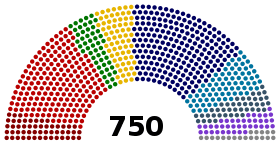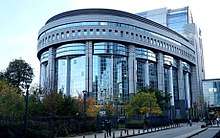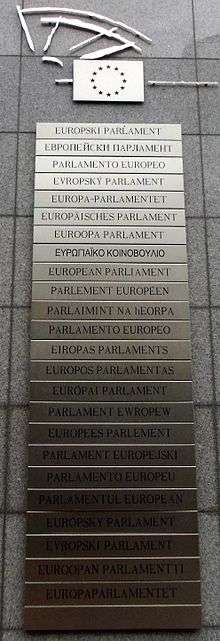ஐரோப்பிய நாடாளுமன்றம்
ஐரோப்பிய நாடாளுமன்றம் (European Parliament, EP) ஐரோப்பிய ஒன்றியத்தின் நேரடியாகத் தேர்ந்தெடுக்கப்படும் நாடாளுமன்ற அமைப்பாகும். ஐரோப்பிய ஒன்றியப் பேரவை, ஐரோப்பிய அணையத்துடன் ஒருங்கிணைந்து இது ஐரோப்பிய ஒன்றியத்தின் சட்டவாக்கச் செயற்பாடுகளை மேற்கொள்கின்றது. இந்த நாடாளுமன்றத்தில் 751 (முன்னதாக 766) நாடாளுமன்ற உறுப்பினர்கள் உள்ளனர்; இந்திய நாடாளுமன்றத்தை அடுத்து உலகின் இரண்டாவது மிகப்பெரும் வாக்காளர்களைக் கொண்ட மக்களாட்சி அமைப்பாகவும் நாட்டு எல்லைகளைக் கடந்த மிகப் பெரிய மக்களாட்சி அமைப்பாகவும் விளங்குகின்றது; தகுதியுடைய வாக்காளர்களின் எண்ணிக்கை 2009இல் 375 மில்லியனாக இருந்தது.[3][4][5]
| ஐரோப்பிய நாடாளுமன்றம் | |
|---|---|
| 8வது ஐரோப்பிய நாடாளுமன்றம் | |
 | |
| தலைமை | |
| தலைவர் | மார்ட்டின் சுல்ட்சு 1 சூலை 2014 முதல் |
| துணைத்தலைவர்கள் | 14
1 சூலை 2014 முதல் |
| மிகப் பெரும்பான்மைக் கட்சியின் தலைவர் | மான்பிரெட் வெபர், ஐரோப்பிய மக்கள் கட்சி 4 சூன் 2014 முதல் |
| இரண்டாவது மிகப்பெரும் கட்சியின் தலைவர் | கியான்னி பிட்டெல்லா, எஸ் & டி 1 சூலை 2014 முதல் |
| அமைப்பு | |
| உறுப்பினர்கள் | 751 ஐ.நா.உ |
 | |
| அரசியல் குழுக்கள் | Commission Majority[1] (472)
Opposition and Non-Aligned (276)
|
| குழுக்கள் | 22
|
| Length of term | 5 ஆண்டுகள் |
| தேர்தல் | |
| Voting system | Party list, STV and First-past-the-post[2] |
| இறுதித் தேர்தல் | 22–25 May 2014 |
| அடுத்த தேர்தல் | 2019 |
| கூடும் இடம் | |
 | |
| 1st: Louise Weiss: ஸ்திராஸ்பூர்க், France (image) 2nd: Espace Léopold: பிரசெல்சு, Belgium Secretariat: Luxembourg & Brussels | |
| வலைத்தளம் | |
| europarl.europa.eu | |


1979ஆம் ஆண்டு முதல் ஒவ்வொரு ஐந்தாண்டுகளுக்கு ஒருமுறை பொது வாக்குரிமை மூலமாகத் தேர்ந்தெடுக்கப்படுகின்றது. இருப்பினும், ஐரோப்பிய நாடாளுமன்றத்திற்கான வாக்காளர் பங்கேற்பு தொடர்ந்து குறைந்து கொண்டே வருகின்றது; 1999 முதல் இது 50%க்கும் குறைவாக இருந்து வருகின்றது. 2014ஆம் ஆண்டில் 42.54% வாக்காளர்களே வாக்களித்தனர்.[6]
குறிப்புகள்
- Participates in Commission but considers itself non-aligned.
மேற்சான்றுகள்
- Even if the European Commission lacks some characteristics of a normal Government, there is an agreement between the main Pro-European forces in the EP on supporting the European Executive. This could be seen as an informal Grand Coalition. See: http://www.alde.eu/nc/press/press-and-release-news/press-release/article/epp-sd-and-alde-to-form-a-stable-majority-in-the-ep-for-the-next-european-commission-43155/
- A single constituency, the German-speaking electoral college in Belgium, also uses First-past-the-post to elect its single MEP
- Brand, Constant; Wielaard, Robert (8 June 2009). "Conservatives Post Gains In European Elections". The Washington Post. Associated Press. http://www.washingtonpost.com/wp-dyn/content/article/2009/06/07/AR2009060702402.html. பார்த்த நாள்: 17 August 2010.
- Ian Traynor (7 June 2009). "Misery for social democrats as voters take a turn to the right". The Guardian (UK). http://www.guardian.co.uk/politics/2009/jun/07/eu-elections-social-democrats. பார்த்த நாள்: 17 August 2010.
- "18 new MEPs take their seats". European Parliament (10 January 2012). பார்த்த நாள் 14 February 2012.
- "Results of the 2014 European elections". European Parliament.